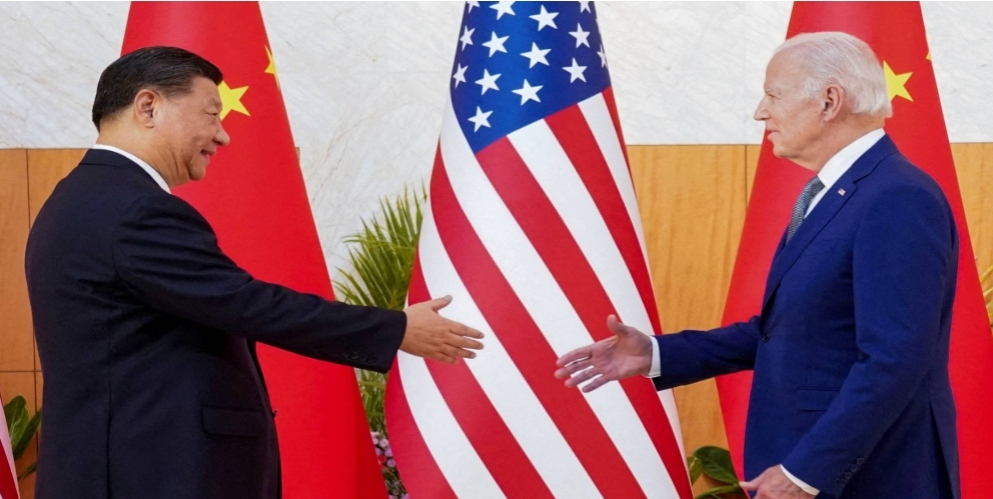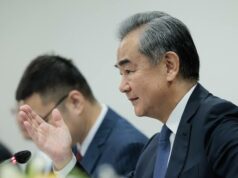No improvement in sight : China-U.S. rivalry to further intensify in 2023

U.S. President Joe Biden meets with Chinese President Xi Jinping on the sidelines of the Group of 20 leaders summit in Bali, Indonesia, on Nov. 14, last year
EDITORIAL Note : The world cannot afford that this rivalry gets out of hand. However a joint Indo Japan can certainly and surely dampen this rivalry.
At their meeting in Bali in November, the leaders of China and the United States raised hopes that the world’s two superpowers would find ways to prevent their rapidly deteriorating relationship from descending into open conflict.
Yet, as neither side appears willing to compromise on contentious issues, experts warn that Sino-U.S. ties will remain fraught, with the rivalry set to intensify this year: Washington will continue to hunt for ways to isolate Beijing politically and further slow its technological rise, while China is expected to keep pressuring Taiwan, buttress ties with Russia and increase its self-sufficiency.
U.S. President Joe Biden and Chinese leader Xi Jinping’s talks “may have helped stabilize relations by re-energizing bilateral dialogues, but numerous thorny issues persist and there is little indication that either side has the political will to address any of the fundamental frictions in a meaningful way,” said Andrew Scobell, with the United States Institute of Peace’s China program.
There may be some tactical adjustment on Beijing’s part but the current trajectory will likely remain the same, said Ian Chong, a professor at the National University of Singapore. Beijing’s slight policy modifications will probably follow the Communist Party’s “talk and fight, fight and talk” approach, where confrontation is interspersed with negotiations to buy time and space for regrouping, he added.
Tensions between the superpowers have remained high in the wake of the Bali summit, with Japan and the Netherlands reportedly agreeing “in principle” to join the U.S. in tightening export controls of advanced chipmaking machinery to China.
Beijing, for its part, has flexed its military muscles, sending a single-day record 71 military aircraft near Taiwan last month after the U.S. approved a bill authorizing up to $10 billion over the next five years to strengthen Taipei’s military capabilities.
Taipei pressure
“While we’ve been hearing rumblings of ‘guardrails’ among U.S. officials and calls from Chinese officials for greater stability in bilateral relations, there is little desire to undertake cooperative steps to achieve that outcome,” said Rebecca Liao, a China expert, entrepreneur and former foreign policy adviser to the presidential campaigns of Biden and Hillary Clinton.
“At this point, each country sees the other as a great competitor, if not an outright enemy,” she said, adding that Taiwan “will remain a key factor shaping Sino-U.S. ties.”
A tank fires during a live-fire military exercise in Pingtung, Taiwan, in September 2022. Experts forecast that Beijing will continue heaping pressure on Taipei in the hopes of shifting cross-strait dynamics in its favor.
Experts forecast that Beijing will continue heaping pressure on Taipei in the hopes of shifting cross-strait dynamics in its favor, particularly in the run-up to Taiwan’s presidential and Legislative Yuan elections early next year.
“Beijing is likely to continue to paint Taiwan and its unwillingness to accept Chinese control as a source of instability” while conducting large-scale military activities around the island, Chong said.
Over the next year, several key events could cause tensions to explode.
In line with its response to then-U.S. House Speaker Nancy Pelosi’s August visit to Taiwan, China could again react with fury should a new Republican speaker decide to also visit Taipei. Rep. Kevin McCarthy, who is seeking the position, said last year he would visit if chosen as speaker.
The possibility of an accident escalating into confrontation has also become an increasingly plausible scenario.
The Pentagon revealed last week that a Chinese fighter jet flew within 3 meters of a U.S. Air Force reconnaissance plane during a recent intercept over the South China Sea, forcing the American plane to take evasive maneuvers to avoid a collision. China denied the claim and blamed the U.S.
To help stabilize ties and find ways to avoid dangerous miscalculations, U.S. Secretary of State Antony Blinken is expected to visit Beijing soon. Meanwhile, bilateral working-level exchanges have restarted.
Employees work on the semiconductor chip production line of Jiangsu Azure in Huaian, Jiangsu province, China, in March 2022. A powder keg for Sino-U.S. ties will be their intensifying technological competition. CHINA DAILY / VIA
Some positive signals have also emerged from Beijing. This week, former Chinese Ambassador to the U.S. Qin Gang — Blinken’s new counterpart as foreign minister — urged the two sides not to allow “prejudice or misperception to ignite confrontation or conflict.”
“The world is wide enough for China and the United States to both develop and prosper,” he wrote in The Washington Post on Wednesday. “We should follow the strategic guidance of our presidents and find the right way to get along for the well-being of the world.”
But despite a stated desire by both sides to repair ties, any improvement is likely to be limited.
“There is deep distrust between the two sides,” Chong said. “This is difficult to bridge, as Washington and Beijing continue to see the world in fundamentally different ways.”
According to Chong, Beijing views Washington’s position as inimical to its aspirations on the global stage, while the U.S. sees China’s approach as a challenge to its long-standing interests.
In terms of stabilizing ties, one area to watch will be the emergence of a new normal in the wake of Beijing’s abrupt end to its “zero-COVID” strategy.
Then-Chinese Ambassador to the U.S Qin Gang at the North American International Auto Show in Detroit in September 2022. China’s new foreign minister urged the two sides not to allow “prejudice or misperception to ignite confrontation or conflict.”
Brian Hart, a fellow with the Center for Strategic and International Studies’ China Power Project, said the end of the policy could spark a rekindling of people-to-people and business exchanges that have languished.
“That will not be a panacea, but it could bring some stability to the relationship,” Hart said.
At the same time, Hart warned that the major COVID-19 outbreak currently hitting China could mean less of a focus on foreign policy as Xi turns his attention to managing domestic affairs. A U.S. recession could also divert Washington’s attention to getting its economy back on track.
Strengthening alliances
In the meantime, the U.S. will look to keep broadening military ties with allies and partners in and outside the region as it seeks more accommodating views of its military posture in preparation for a possible escalation with China.
Washington, for example, is continuing its support of Japan’s security reorientation while also providing arms and military aid to Taiwan and working more closely with the Philippines to bolster its military posture.
Cooperation with allies and partners, particularly Japan and Australia, is also driven by their own concerns about China’s actions, which has driven their increased investment in military capabilities.
In response to these trends, China is likely to step up pressure on countries within the U.S. orbit in a bid to blunt Washington’s partnership network.
“The People’s Liberation Army and paramilitary forces like the ‘maritime militia’ may play a role in such actions through deployments and exercises,” Chong said, referring to China’s thousands of fishing and other vessels that also serve in militia roles.
A medical worker checks the IV drip of a patient in the emergency department of a hospital in Shanghai on Thursday. The major COVID-19 outbreak currently hitting China could mean less of a focus on foreign policy as Xi turns his attention to managing domestic affairs.
Concurrently, Beijing will continue modernizing its military while also keeping up diplomatic efforts to portray U.S. alliances and cooperative security arrangements in Asia as fundamentally destabilizing and even dangerous for the region, Chong added.
Unlike Washington, Beijing doesn’t have an extensive network of security alliances. That said, China’s growing military ties with Russia are expected to remain a major sticking point in its relationship with the U.S. as Moscow’s war in Ukraine drags on.
More tech restrictions
Another powder keg for Sino-U.S. ties will be their intensifying technological and geoeconomic competition, as Washington aims to expand unprecedented export restrictions of critical technologies to China, either unilaterally or through joint efforts.
Zhang Baohui, a professor at Hong Kong’s Lingnan University, said that this tech “decoupling” will deepen, moving the world toward a bifurcated order that forces many countries to choose sides. Firms caught in the middle are likely to reduce investment in or procurement from China as they seek to mitigate political risks from the intensifying rivalry.
This year could also see the U.S. “shift to isolating China politically,” said Rafiq Dossani, director of the Center for Asia Pacific Policy at the Rand Corp.
“Washington has announced that it will seek to reshape the strategic environment in Asia,” he said. “I take that to mean a focus on Southeast Asia to try and convince these countries to mainstream an industrial policy based on national security, rather than today’s laissez-faire approach.”
How will China react?
In response, Beijing is likely to focus on promoting self-sufficiency while turning its attention to other markets, particularly developing nations.
China will continue to try and acquire key technologies from overseas in the short run while developing domestic substitutes in the longer term to offset dependency on foreign tech, Chong said.
According to media reports, China is working on a more than 1 trillion yuan ($145.8 billion), five-year support package, mainly in the form of subsidies and tax credits, to bolster semiconductor production and research activities at home.
At the same time, top Chinese officials are reportedly discussing how to move away from costly subsidies and investments in the country’s big semiconductor funds, and instead focus on alternative ways to assist homegrown chipmakers, such as by lowering the cost of semiconductor materials.
Taiwan President Tsai Ing-wen speaks at a news conference on new measures to reinforce the island’s civil defense amid the rising China military threat, in Taipei on Dec. 27.
Beijing will also redouble efforts to push its Belt and Road initiative, which appears to be making more headway in Central Asia, Africa and Latin America than in South and Southeast Asia, he added.
Ultimately, though, Sino-U.S. ties are unlikely to improve anytime soon, experts say, as the two powers’ strategic rivalry becomes increasingly “institutionalized.”
And while there are some in Washington calling for a kind of mutual accommodation, the key will be Beijing’s ability to credibly commit to self-restraint and an offer by the United States of concessions on some topics of contention, Chong said.
Both, however, seem unlikely at this point as the two sides dig in.
The trajectory for competition seems here to stay for the next several years.
By Gabriel Dominguez



